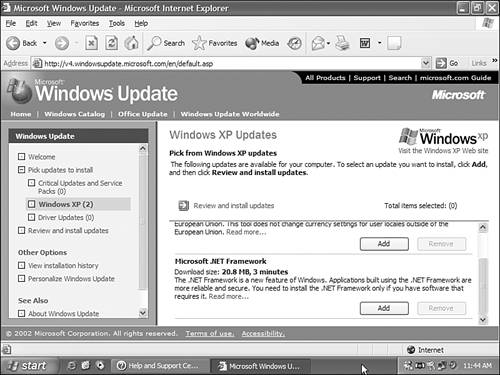Windows Update
| Windows Update serves to synchronize your operating system files with the newest developments for it at Microsoft. These can include free programs, security updates, bug fixes, drivers, or other extensions to the operating system. Using the Internet and Web technologies for updating your operating system means you don't have to wait for the next release of the operating system or install service packs to get interim updates. Obtaining New UpdatesThe Windows Update command is found in several places, including the top of the All Programs section of the Start menu and on the Tools menu of Internet Explorer. Manually launching Windows Update gives you the ability to selectively download offered updates. However, you can easily configure Windows XP to download all relevant updates automatically. This setting is made on the Automatic Updates tab of the System applet (see the discussion earlier this chapter). NOTE Another Start menu item in the same category as Windows Update is Windows Catalog. This tool opens an Internet Explorer window to the Windows Catalog Web site. This site maintains a database of products made for Windows, including applications, devices, and complete PCs. Microsoft is very keen on having you visiting the update Web site regularly. To do so, you can simply connect to the Net, and choose Start, All Programs, Windows Update. A typical page at the Web site looks like the one shown in Figure 27.16. The look of the pages and the list of updates obviously change from week to week, so what you see there might differ slightly from what you see here. Figure 27.16. Visit the Windows Update site regularly to keep Windows XP up-to-date. The ActiveX components that run when you visit the site scan your computer to determine what updates have been made in the past and which ones are outstanding. According to Microsoft, no corporate espionage or personal eavesdropping ensues during the process of system analysis. This is accomplished by downloading a master list of available updates and allowing a client-side component to determine which items are applicable to your system. Other than making requests for the master list of updates and for downloading the selected updates, no information is sent to Microsoft.
The first time you run it, the update tool creates a database of consummated updates on your computer. This information allows the installer to do the following:
Look for a History button on the Web page (not the History button on the Internet Explorer toolbar, obviously) to see what you installed and when. Using Rollback to Uninstall a Windows UpdateIf you notice unruly system behavior after updating drivers, patches, or system files from Windows Update, you'll probably want to roll back your system to its previous state. You can remove such items by using the Update site. Look for instructions about uninstalling items there. You might have to display past updates by clicking the View Installation History button on the Web page. Then you can scroll down to the update and click Uninstall. If you don't have Web access, are you sunk? No. Good thing, because you could conceivably make an update only to find it kills your networking or Web access. Some items, such as standalone programs, can be removed via the Control Panel's Add/Remove Programs applet, so check there to remove something such as FrontPage Express or non-Microsoft applications. Of course, you can't use this approach to roll back system files, patches, or drivers. To do that, you can use System Restore capability of Windows XP. Please see Chapter 33 for details. |
EAN: 2147483647
Pages: 450
- Challenging the Unpredictable: Changeable Order Management Systems
- ERP System Acquisition: A Process Model and Results From an Austrian Survey
- Enterprise Application Integration: New Solutions for a Solved Problem or a Challenging Research Field?
- Distributed Data Warehouse for Geo-spatial Services
- Data Mining for Business Process Reengineering